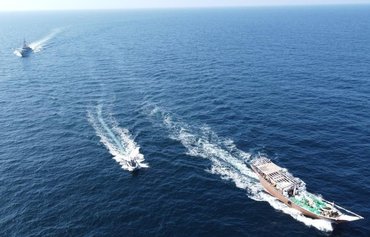The Iranian regime is continuing to blame others for maritime insecurity in the Arabian Sea and Gulf of Oman even as it engages in piracy, weapons and drugs smuggling and attacks on the high seas.
A confidential United Nations (UN) report concluded that thousands of rocket launchers, machine guns, sniper rifles and other weapons seized in the Arabian Sea by the US Navy in recent months likely originated from a single port in Iran, The Wall Street Journal reported Saturday (January 8).
Since September 2015, international naval forces have carried out at least 12 maritime interdictions of Iranian weapon shipments believed to have been destined for the Houthis in Yemen.
In the latest interception on December 20, US Navy ships seized approximately 1,400 AK-47 assault rifles and 226,600 rounds of ammunition from a stateless fishing vessel in the North Arabian Sea.
![US 5th Fleet ships on December 20 seized approximately 1,400 AK-47 assault rifles and 226,600 rounds of ammunition from a stateless fishing vessel assessed to have originated in Iran. [US Navy]](/cnmi_am/images/2022/01/12/33511-navy-seizure-yemen-600_384.jpg)
US 5th Fleet ships on December 20 seized approximately 1,400 AK-47 assault rifles and 226,600 rounds of ammunition from a stateless fishing vessel assessed to have originated in Iran. [US Navy]
Iran uses small wooden boats departing from the Iranian port of Jask on the Sea of Oman to smuggle such weapons, according to the UN report by the Security Council panel of experts on Yemen, citing interviews with Yemeni crews and data from navigational instruments.
"Iran has developed a multitude of ways to deliver weapons to Yemen and has never stopped," said a senior US official cited by the Journal. "Every time we make some new seizures, Iran finds a new way to move weapons."
Iran deflects blame
The United States as well as ally Saudi Arabia -- which leads the military coalition backing the Yemeni government -- have long accused Iran of supplying the Houthis with weapons, a charge Tehran denies.
Iranian officials have long attempted to deflect blame for causing maritime insecurity while demanding accountability from others.
Last month Iranian Supreme National Security Council secretary Ali Shamkhani attempted to blame the presence of Israel in the Persian Gulf for the recent maritime problems, Iran's Press TV reported, while in August, following the attack on the Israel-managed Mercer Street tanker in the Arabian Sea off the coast of Oman, Iranian officials accused the United States and its allies of creating artificial maritime "incidents" in the Persian Gulf.
"The deployment -- for well over a decade -- of Iran's naval forces to the Indian Ocean and the adjacent areas in support of international efforts in combating piracy therein has repeatedly been acknowledged by the United Nations Secretary-General in his relevant reports and commended by the Security Council in its numerous resolutions," Zahra Ershadi, Iran's deputy ambassador to the UN, said after denying responsibility for the attack.
Iran enjoys long coasts and numerous port facilities in the Caspian Sea, the Persian Gulf and the Sea of Oman as well as high maritime shipping capacity, she said, adding that it attaches "great importance to the maritime security and freedom of navigation".
Evidence points to Iran
Yet evidence abounds of Iran and its proxies' involvement in a number of maritime incidents.
Most recently, the Houthis on January 2 hijacked the United Arab Emirates (UAE)-flagged Rwabee with its international crew in the Red Sea off the Yemen coast.
The ship's 11 crew members are still being held on board, in what the UAE has described as an "act of piracy".
A US official based in the region said it appeared to be the first ship hijacking by the Houthis since they seized three in late 2019, AFP reported.
The United States on August 4 also said Iran was involved in the hijacking of the Asphalt Princess, an asphalt and bitumen tanker, in the Gulf of Oman.
Meanwhile, forensic evidence has tied Iran to a host of attacks in the region carried out via unmanned aerial vehicles (UAVs), commonly known as drones, including those purportedly carried out by the Houthis.
In early August, the Pentagon announced that investigations into the July 29 drone attack on the Mercer Street tanker produced clear evidence that Iran was behind the incident.
A British security guard and the ship's Romanian captain were killed.
Shifting blame
"The Iranians produce about six types of assault drones, the most prominent of which are Fotros, Shahed and Yasir," Iraqi military and strategy analyst Alaa al-Nashou told Al-Mashareq.
These aircraft operate using technology imported from Russia, China and North Korea and can carry explosives over a range of hundreds of miles, he said.
Drones have become Iran's weapon of choice to threaten regional security, he said, because of their "low manufacturing costs and ability to infiltrate and reach the selected targets".
While Iran attempts to hide its hand through the use of such weapons, he said, international investigations and evidence recovered from the scene of the attacks confirm its involvement.
Iran is "equipping its proxies with the components of these aircraft and providing them with expertise and advice on how to assemble them and training on operating them", he added.

![A billboard depicting Iran's Islamic Revolutionary Guard Corps navy units observing a US warship in the Gulf of Oman is seen at Vali-Asr square in Tehran on November 5. [AFP]](/cnmi_am/images/2022/01/12/33483-Tehran-billboard-irgc-600_384.jpg)






